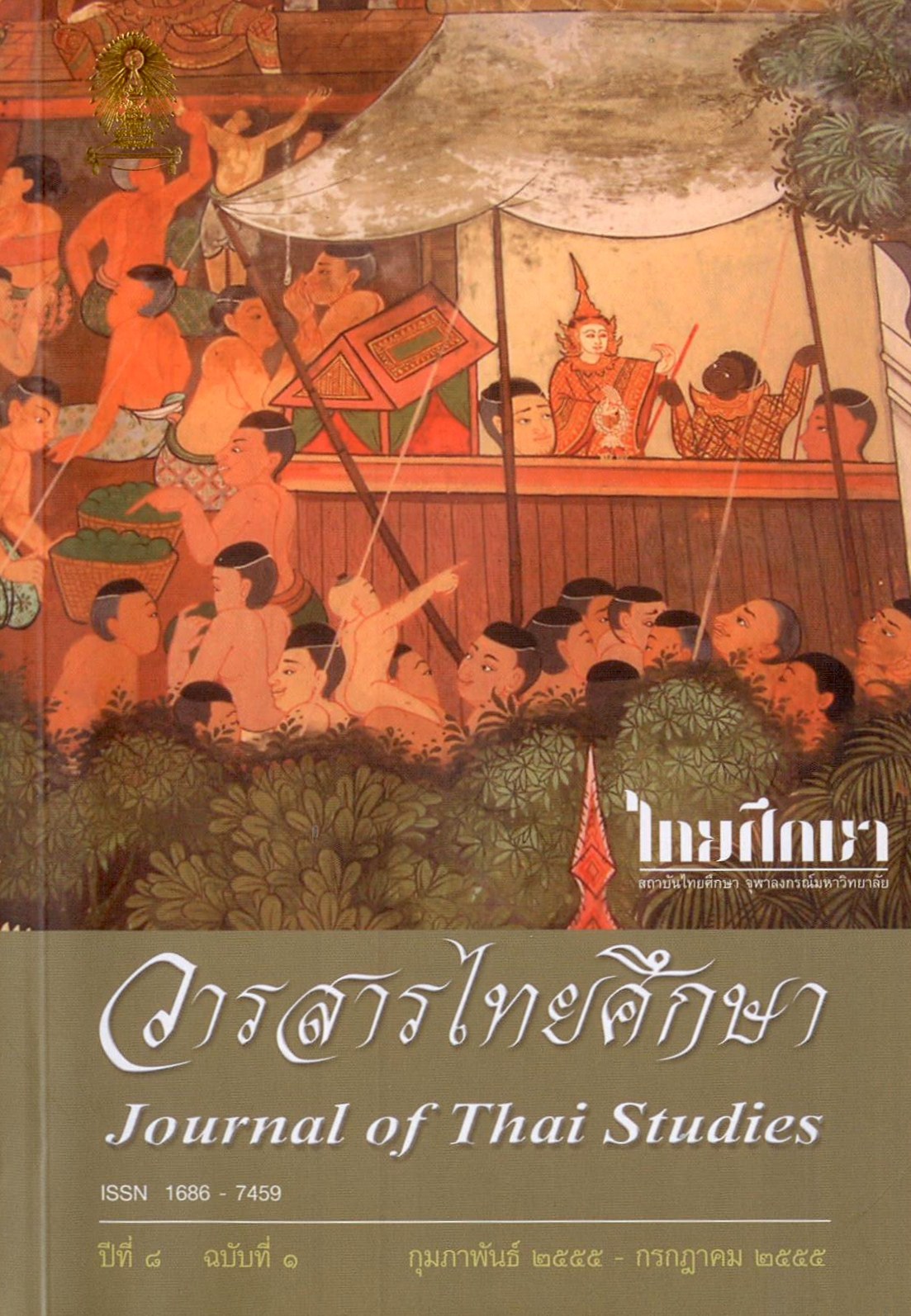The Persistence of Inthakin Pillar Worship: The Integration between Indigenous Belief and Buddhism in Present Day Rituals
Main Article Content
Abstract
This paper aims at examining and analyzing the persistence of Inthakin pillar worship, which today has become one of the rituals performed in connection with the worship of the Chiangmai city guardian spirits. The analysis identifies the characteristics of religious integration between indigenous belief and Buddhism from both concrete components, such as ritual space, ritual offerings, ritual performance, and abstract components, such as belief, social value, and ritual meaning. The research reveals that with respect to both components, more and more of a Buddhist element has been inserted into the Inthakin pillar worship such that the ritual performance is now presented as a Buddhist ritual. The indigenous belief in the city pillar, which was the origin of the ritual, has now been partially replaced in its meaning by Buddhism, leaving only a certain role and meaning of the indigenous belief to persistent in the ritual.
Article Details

This work is licensed under a Creative Commons Attribution-NonCommercial-NoDerivatives 4.0 International License.
Journal of Thai studies is licensed under a Creative Commons Attribution-Noncommercial-NoDerivatives4.0 Intenational (CC BY-NC-ND 4.0) licence, unless otherwise stated. Plese read our Policies page for more information on Open Access, copyright and permissions.
References
ตำนานพื้นเมืองเชียงใหม่ ฉบับเชียงใหม่ ๗๐๐ ปี. เชียงใหม่: ศูนย์วัฒนธรรมจังหวัดเชียงใหม่ สถาบันราชภัฎเชียงใหม่, ๒๕๓๘.
ประสิทธิ์ เลียวสิริพงษ์. อินทขีล : เสาซึ่งมิได้เป็นเพียงเสา.ใน เอกสารรวมบทความการประชุมสัมมนาเรื่อง ความเชื่อและพิธีกรรม: ภูมิปัญญาชาวบ้านไทย–ไท. เชียงใหม่: สถาบันราชภัฎเชียงใหม่, ๒๕๓๗.
พระครูโสภณกวีวัฒน์. เล่าขานตำนานประเพณีอินทขีล หลักเมืองเชียงใหม่. ใน ประวัติวัดเจดีย์หลวง, หน้า ๗๕. เชียงใหม่: ทั้งฮั่วซินการพิมพ์, ๒๕๔๗.
พระธรรมดิลก. ตำนานอินทขีล. ใน ประวัติวัดเจดีย์หลวงวรวิหาร, หน้า ๕๗. เชียงใหม่: ทั้งฮั่วซินการพิมพ์, ๒๕๔๗.
มณี พยอมยงค์. ประเพณีสิบสองเดือนล้านนาไทย. เชียงใหม่: ส.ทรัพย์การพิมพ์, ๒๕๓๗.
อานันท์ กาญจนพันธุ์. ล้านนาในมิติทางวัฒนธรรม. ใน เอกสารประกอบการบรรยายวิชาสังคมและวัฒนธรรมภาคเหนือ คณะสังคมศาสตร์ มหาวิทยาลัยเชียงใหม่. (ม.ป.พ: ม.ป.ท, ๒๕๓๕, หน้า ๙๕- ๑๑๕ อ้างถึงใน สุรพล ดำริห์กุล, ข่วงเมืองและวัดหัวข่วง: องค์ประกอบสำคัญของเมืองในดินแดนล้านนา. กรุงเทพฯ: สำนักพิมพ์แห่งจุฬาลงกรณ์มหาวิทยาลัย, ๒๕๔๙.
อานันท์ กาญจนพันธุ์. พิธีไหว้ผีเมืองและอำนาจรัฐในล้านนา. ใน สังคมและวัฒนธรรมในประเทศไทย, หน้า ๑๕๑ – ๑๖๑. กรุงเทพฯ: ศูนย์มานุษยวิทยาสิรินธร, ๒๕๔๒.
อานันท์ กาญจนพันธุ์. พิธีไหว้ผีอารักษ์ของชาวลัวะ บ้านดง อ.แม่ลาน้อย จ.แม่ฮ่องสอน. [ออนไลน์]. แหล่งที่มา http://www.sac.or.th/databases/anthropological_archive/archive_search.php?page=9&pagesize=50&s=subject&q=--M-- ๒๕๕๔, เมษายน ๒๐]
สัมภาษณ์
จันทร์เพ็ญ ทิพย์ชัยภัทร. สัมภาษณ์, ๓ มิถุนายน ๒๕๕๔.
ชัชวาลย์ ทองดีเลิศ. สัมภาษณ์, ๑๑ มิถุนายน ๒๕๕๒.
บุญเลี่ยม คุณเลิศ. สัมภาษณ์, ๒๐ พฤษภาคม ๒๕๕๒.
บัวแก้ว ดวงแก้ว. สัมภาษณ์, ๒๑ มกราคม ๒๕๕๓, ๓๐ พฤษภาคม ๒๕๕๔.
ปราณี เชียงวัดเกตุ. สัมภาษณ์, ๒๐ พฤษภาคม ๒๕๕๒.
พีรพงศ์ สิทธิเทพ. สัมภาษณ์, ๑๗ กรกฎาคม ๒๕๕๓.
มูล แซ่ฉั่ว. สัมภาษณ์, ๒๙ พฤษภาคม ๒๕๕๔.
สุพัตรา นันทวงศ์. สัมภาษณ์, ๒๐ พฤษภาคม ๒๕๕๒.
สิงห์คำ ดวงดอก. สัมภาษณ์, ๑๔ กุมภาพันธ์ ๒๕๕๔.
สมศักดิ์ อุ่นเรือน. สัมภาษณ์, ๒๙ พฤษภาคม ๒๕๕๔.
อัมพร ตันคำปาน. สัมภาษณ์, ๓๐ พฤษภาคม ๒๕๕๔
